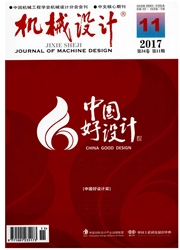

 中文摘要:
中文摘要:
针对一种高速重载码垛机器人机座的多目标优化设计进行研究。对码垛机器人进行运动学分析、工作空间分析及力学分析,得到机座所受的力和力矩的最大值。建立了机座的有限元模型并通过模态对比试验,校验有限元模型的准确性。通过静力学分析,得到机座的最大应力和位移。通过振动试验。获得机器人工作时机座所受激振力的频率。由以上测试与分析结果确定.以质量最小、最大位移最小为目标,以第1阶固有频率不降低、最大应力小于许用应力为约束条件。通过灵敏度分析选取设计变量,并以其取值范围为约束条件.利用Box—Behnken试验设计和RSM法构造目标函数和约束函数的近似模型,并通过了可信度验证,建立了多目标优化模型。采用NSGA一Ⅱ算法进行求解,得到了优化结果。对比分析表明,在保证强度、刚度及振动稳定性的情况下,质量减轻了8.7%,验证了优化设计的有效性。
 英文摘要:
英文摘要:
Multi-objective optimization design of the machine base of a high speed and heavy load palletizing robot is re- searched. The maximal force and torque on the machine base is determined by kinematics analysis,workspaee analysis and me- chanical analysis of palletizing robot. The finite element model is established, and its accuracy is verified by contrastive analysis of modal test and finite element modal analysis. Maximum stress, maximum deformation value of the machine base is solved by the static analysis. The frequency of vibration force on the machine base in the process of the robot work is measured by vibra- tion test. According to the above test and analysis results, using the minimal mass and the maximum deformation value tends to minimum as the optimization objective; using the maximum stress is less than allowable stress, the first-order natural frequency is less than the initial model's as the constraint conditions. The design variables are selected by sensitivity analysis and scope of design variables as the constraint conditions too. Approximation models of optimization objective functions and constraint func- tions are established by the Box-Behnken design and the RSM method, and reliability of approximation models meet the engi- neering requirements through precision verification. A multi-objective optimization model is established. The multi-objective op- timization problem is solved by the NSGA-II algorithms and optimization results are given. The machine base before and after optimization were compared and analyzed results show that on the premise of strength, stiffness and vibration stability require- ment, the mass of the machine base is lightened by 8.7%, this result testifies the efficiency of the muhi-objective optimization design method.
 同期刊论文项目
同期刊论文项目
 同项目期刊论文
同项目期刊论文
 期刊信息
期刊信息
